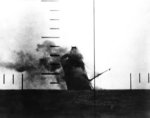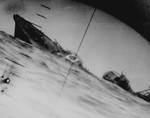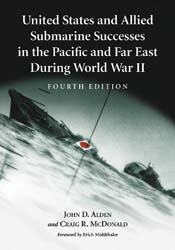Submarine Operations Research Group Attack Data
During the war the Submarine Operations Research Group (SORG), under Commander Submarines, Pacific (ComSubPac), listed and assessed all reported submarine attacks. It took into account the commanding officers' patrol reports, the comments of higher commanders in their endorsements to the reports, and the limited information available from radio traffic with submarines that were lost or other sources. SORG tabulations by date and hour of attack and also by boat and patrol number were used. These were classified SECRET until well after the war.

 It is apparent that little intelligence information was made available to SORG. So-called ULTRA information obtained from decrypted Japanese messages was not provided. Data entries in SORG are: date (month/day/year), hour, light condition, operational command (headquarters), latitude, longitude, type of approach and attack, torpedo model, torpedoes fired, hits, target type, result, estimated target tonnage, submarine hull number, and patrol number. The 'result' data represents SORG's assessment of the success of the attack with, in most cases, no knowledge of the identity of the actual target. SORG's assessments of sinkings and damage, as well as those of target tonnage, almost always agree with those of the operational commanders. Unfortunately, they are greatly overestimated in comparison with postwar analyses. Although this was already known during the war to the few people who had knowledge of ULTRA findings, it was not revealed lest the Japanese find out that their codes were being broken. The SORG assessments, however, have been given certain credence by being cited in the U.S. government publication United States Submarine Losses, World War II.
It is apparent that little intelligence information was made available to SORG. So-called ULTRA information obtained from decrypted Japanese messages was not provided. Data entries in SORG are: date (month/day/year), hour, light condition, operational command (headquarters), latitude, longitude, type of approach and attack, torpedo model, torpedoes fired, hits, target type, result, estimated target tonnage, submarine hull number, and patrol number. The 'result' data represents SORG's assessment of the success of the attack with, in most cases, no knowledge of the identity of the actual target. SORG's assessments of sinkings and damage, as well as those of target tonnage, almost always agree with those of the operational commanders. Unfortunately, they are greatly overestimated in comparison with postwar analyses. Although this was already known during the war to the few people who had knowledge of ULTRA findings, it was not revealed lest the Japanese find out that their codes were being broken. The SORG assessments, however, have been given certain credence by being cited in the U.S. government publication United States Submarine Losses, World War II.
Despite its limitations, the SORG compilation is a generally accurate summary of the data in patrol reports; as such it is handier to work with than the original patrol reports. In addition to the ULTRA problem, SORG's assignment of partial credit to two or more submarines in certain cases has proven to be incorrect. Another shortcoming is that SORG gives the time of attack rounded off to the nearest hour, and more seriously, shows the time as given in the patrol report without consideration of the zone time being used. Since Japanese reports all used Tokyo time, submarine time reported in a different zone must be corrected before the reports can be compared.
Main Menu
List SORG Data by Submarine
Advanced Search
 |
|
A complete analysis of the SORG attack data and attacks not in SORG is currently available in the book United States and Allied Submarine Successes in the Pacific and Far East During World War II, 4th ed.
More Info About the Book:
McFarland & Company
Amazon
Back to Main SORG Page
|


Related Partner Sites:
Combined Fleet Message Board |
J-Air Forum |
WW2 Database |
IJN Doctrine |
3-D IJN Warships

 It is apparent that little intelligence information was made available to SORG. So-called ULTRA information obtained from decrypted Japanese messages was not provided. Data entries in SORG are: date (month/day/year), hour, light condition, operational command (headquarters), latitude, longitude, type of approach and attack, torpedo model, torpedoes fired, hits, target type, result, estimated target tonnage, submarine hull number, and patrol number. The 'result' data represents SORG's assessment of the success of the attack with, in most cases, no knowledge of the identity of the actual target. SORG's assessments of sinkings and damage, as well as those of target tonnage, almost always agree with those of the operational commanders. Unfortunately, they are greatly overestimated in comparison with postwar analyses. Although this was already known during the war to the few people who had knowledge of ULTRA findings, it was not revealed lest the Japanese find out that their codes were being broken. The SORG assessments, however, have been given certain credence by being cited in the U.S. government publication United States Submarine Losses, World War II.
It is apparent that little intelligence information was made available to SORG. So-called ULTRA information obtained from decrypted Japanese messages was not provided. Data entries in SORG are: date (month/day/year), hour, light condition, operational command (headquarters), latitude, longitude, type of approach and attack, torpedo model, torpedoes fired, hits, target type, result, estimated target tonnage, submarine hull number, and patrol number. The 'result' data represents SORG's assessment of the success of the attack with, in most cases, no knowledge of the identity of the actual target. SORG's assessments of sinkings and damage, as well as those of target tonnage, almost always agree with those of the operational commanders. Unfortunately, they are greatly overestimated in comparison with postwar analyses. Although this was already known during the war to the few people who had knowledge of ULTRA findings, it was not revealed lest the Japanese find out that their codes were being broken. The SORG assessments, however, have been given certain credence by being cited in the U.S. government publication United States Submarine Losses, World War II.

